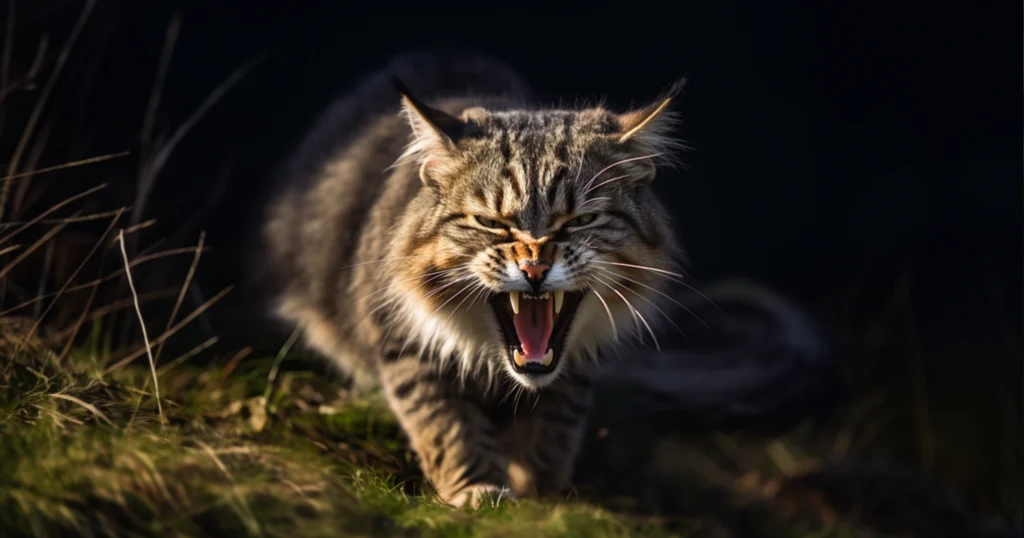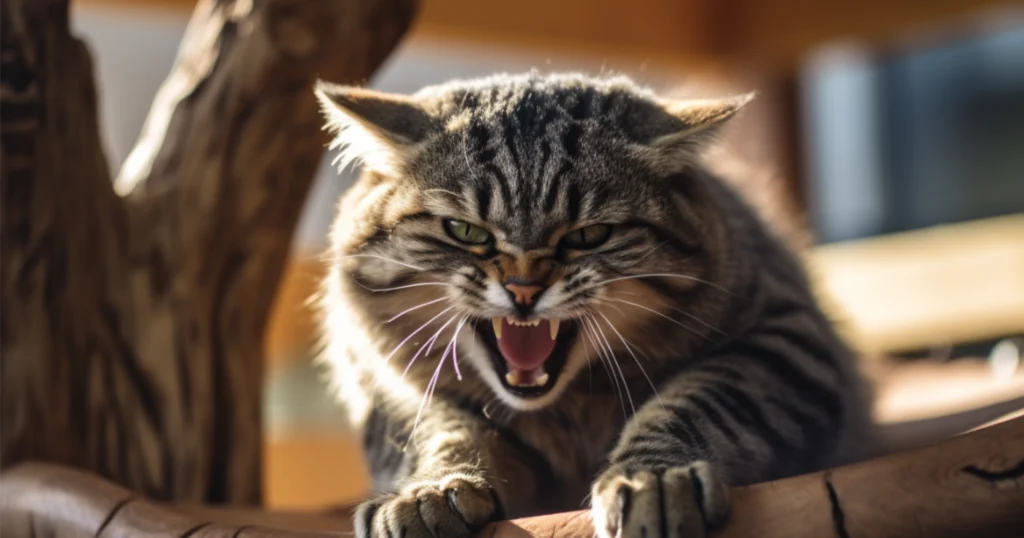When it comes to the enigmatic world of cat communication, the purrs, meows, and chirrups are only the tip of the feline language iceberg. Deeper still lies an array of varied vocalizations that whisker-whisper stories of curiosity, delight, distress, or discontent. Among these varied symphonies, two stand out for their singular intensity – the hiss and the growl.
This exploration aims to lead you through the undergrowth of feline discourse and decipher the essence of these two distinct utterances. When does a cat hiss? Why the sudden growl? In decoding these, we do more than just satisfy a curiosity. We unveil a layer of understanding that brings us closer to our feline companions, enhancing our shared bonds and enriching their lives as well as ours. So, fasten your curiosity belts as we delve into the realm of cat hisses and growls, uncovering the meanings hidden beneath the surface.
Understanding Cat Communication

Understanding cat communication is more than a whimsical foray into the feline psyche; it’s a necessary step towards enhancing the bond between humans and their furry counterparts. Much like any other language, cat-speak is rich, nuanced, and can lend profound insights into your pet’s emotional state, preferences, and needs.
Cats, in their own right, are dynamic creatures, with complex behaviors and communications that extend far beyond the traditional meow. Hissing and growling, often misunderstood as merely aggressive or undesirable, are in fact, integral components of normal feline behavior. Recognizing these not as aberrations but as meaningful dialogues opens up an avenue for deeper understanding and respect for our feline companions.
When a cat hisses or growls, it’s expressing a narrative steeped in instinct, emotion, and communication. These sounds are far from arbitrary. They serve as important communicative tools that signal discomfort, stress, or fear. They may appear confrontational, but they are often defensive responses, rooted deeply in the cat’s nature.
In essence, learning to interpret hisses and growls is an essential step in human-cat cohabitation. It allows us to appreciate the full spectrum of our cat’s communication, react appropriately, and cater better to their well-being. So, let’s proceed to demystify these feline vocalizations, one hiss and growl at a time.
Why Do Cats Hiss?

Expression of Discomfort, Fear, or Stress
A cat’s hiss can be likened to an early warning system, a manifestation of discomfort, fear, or stress. It’s an audible alarm bell that signals, “I’m not comfortable with this situation.” Whether it’s the sight of an unknown entity, the discomfort of a sudden change in environment, or the stress from an ongoing tussle, hissing acts as a barometer for their emotional turmoil. It’s a reaction rooted deep in a cat’s evolutionary history, a testament to their wild ancestry where survival hinged on quick responses to threats.
Warning Sign to Back Off
Moreover, the hiss is a cat’s not-so-subtle hint that they’d like you to back off, pronto. A hiss is a clear, unequivocal boundary set by our feline friends, especially when they perceive their territory to be under threat. Remember, in the cat world, territory isn’t just limited to physical space. It can encompass favorite toys, resting spots, or even their human companions. A sudden hiss might just be your cat’s way of expressing territorial concerns.
Possessiveness
Possessiveness, too, can trigger hisses from even the most placid cats. A new pet, a visitor paying too much attention to their favorite human, or simply another cat hogging the shared scratching post could potentially stir possessive instincts. This possessiveness is a part of their instinctive behavior, their way of asserting, “This is mine.” So, the next time you hear that distinctive hiss, pause and consider – have you, perhaps inadvertently, treaded onto their perceived territory?
Why Do Cats Growl?

Aggressive or Nervous Body Language
Just as with hissing, a cat’s growl can communicate a range of emotions. This deep, guttural sound is often linked to aggressive or nervous behavior. The body language that accompanies it can include a puffed-up tail, flattened ears, dilated pupils, and a hunched or stiff body position. It’s a potent cocktail of signals all shouting the same message – “I’m not happy and I’m ready to defend myself.” Recognizing these cues can help you step back, give your cat the space they need, and avoid a potential confrontation.
Displaying Dominance
In a multi-cat household, the growl may take on another function – establishing dominance. This is particularly prevalent during feeding times or when new toys or resources are introduced. A growl can convey the cat’s command over these resources, asserting their top cat status to their feline cohabitants. Remember, while this may appear aggressive to humans, it’s a natural part of cat behavior, a language that, if understood correctly, can help maintain peace within the household.
Invasion of Personal Space
Finally, the growl can also be a vocal manifestation of a cat’s disdain for its personal space being invaded. Cats are notoriously territorial, and while some may enjoy a good cuddle session, many have very clear boundaries about how and when they prefer to be touched. If a boundary is crossed – be it an over-eager child, a clumsy dog, or even an unfamiliar human – the growl serves as a clear sign that they’ve had enough. By heeding this warning, we can respect their space and ensure a harmonious coexistence.
Remember, a growling cat is simply communicating its needs. Rather than punishing the behavior, understanding and responding appropriately can lead to a more harmonious relationship with our feline companions.
What To Do When Cats Hiss and Growl?

Giving Space
When the hisses and growls echo, it’s a signal from your cat to step back. They’re communicating a clear message: “I need space. Now.” Respecting their wish for solitude isn’t optional, it’s crucial. Even though your instinct might scream at you to comfort them, it might exacerbate their anxiety. The best thing? Simply allow them some time alone. It’s their way of regaining composure and will prevent any unnecessary escalation.
Ensuring Comfort
Harmony ensues when your cat’s basic needs are met. An abundance of food, a never-ending supply of fresh water, a spotless litter box, a cozy nook to curl up in, and plenty of stimulating activities pave the way for tranquility. Encouraging early social interaction also aids in nurturing a more composed demeanor. A household filled with care, love, and predictability minimizes stress, turning your abode into a haven for your feline friend.
Professional Help
Persistent growls and hisses, especially those paired with physical aggression, should never be ignored. They could be alarm bells for underlying health issues, warranting a vet’s intervention. If the household feels more like a warzone despite your best efforts, consider reaching out to a cat behaviorist. They can help restore peace and harmony. Remember, asking for help isn’t admitting failure. It’s about securing the well-being of your feline friend and creating a happier, more balanced living environment. Expert guidance can be a godsend in such scenarios.
Conclusion
Cats have their own unique language, and as their caretakers, it’s important we understand it. Key sounds to recognize are hisses and growls. Hissing can indicate discomfort, fear, stress, or possessiveness, and it’s often a warning sign to others. Growling might hint at aggression or nervousness, display dominance, or express discomfort with boundaries being crossed.
Responding appropriately to these sounds is crucial. When your cat hisses or growls, giving them space is often the best approach. Maintaining a comfortable, stress-free environment can help prevent such behaviors. In case these behaviors persist or escalate, don’t hesitate to consult with professionals.
Remember, the aim is to create a loving bond with your feline friend, and understanding their unique language is the first step towards achieving that goal. Through empathy and understanding, you can enhance your relationship with your cat and make your shared environment a haven of peace and contentment.


